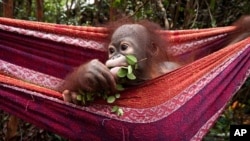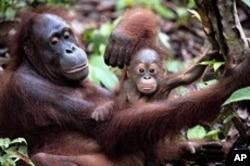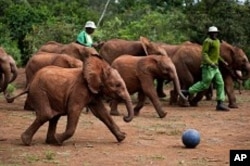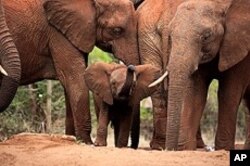A new IMAX film uses 3D technology to take audiences into remote locations on opposite sides of the globe where dedicated teams work to save orphaned wildlife. Here's a look at Born To Be Wild.
"We've shared this planet since the dawn of man, but as our world expands into theirs, more and more wild animals lose their families, and their very existence on Earth is in danger."
With Oscar-winning actor Morgan Freeman as narrator, Born To Be Wild goes behind the scenes at a unique refuge in Kenya where surviving babies of elephants slain by poachers are rescued, raised and released back into the wild.
"It's been over 50 years since Daphne Sheldrick first adopted orphaned elephants. She has created a safe haven for them at a very special nursery just outside Nairobi," Freeman narrates. "These little orphans have been rescued from all over Kenya. They may look big, but they are just little children."
The film hops the globe to Borneo (in the south pacific) where Birute Mary Galdikis has a similar nursery for orphaned baby orangutans.
"All these orangutans are here for one reason. Their mothers have been killed and their forest home cut down. These are the lucky ones who survive."
Dr. Galdikis says her project in a remote Indonesian jungle demonstrates why it is important for governments and businesses to understand the impact of development on wildlife habitats.
"On one hand, they do want to protect orangutan populations. They do want to protect tropical rainforests," the doctor explains. "But on the other hand, they are making so much money off these forests, especially off palm oil plantations, that it's very easy to destroy those forests and make money. Clearly, without the support of the government, I would not have been able to work in Kalimantan, which is Indonesian Borneo, for 40 years like I have. But on the other hand, those forests are disappearing."
In Kenya, elephant advocate Daphne Sheldrick says outreach to a new, younger generation has made a difference.
"Every single day in the Nairobi nursery, we open our doors to the public and hundreds of schoolchildren come filing in to see the elephants," Sheldrick says. "They talk to the keepers, they learn about the nature of elephants [and] what very human animals they are in many ways, gradually engendering a love of animals amongst the Kenyan nation. I think in Kenya there is probably more interest in the nature of elephants than in any other country in Africa. They really do appreciate them and the orphans have been very instrumental in passing that message."
It is that urgent message which drew Morgan Freeman to the film.
"You get calls to do narrations - lots of them - and then once in a while a project comes along that, to use an over-used word, resonates," notes Freeman. "I think this particular project is extremely important and well worth doing because, number one, it highlights a couple of ladies whose courage and dedication really should be trumpeted. And it also highlights the danger of what we are doing as humans in terms of the rest of the life on the planet."
"These orphans grow up so differently than wild orangutans, but as long as they feel loved they'll have the confidence they'll need later in life."
The projects at Orangutan Foundation International and the Sheldrick Wildlife Trust have the same goal: to enable the orphaned animals to rejoin their counterparts in the wild. As the film portrays, emotional bonds are forged between the human surrogate parents and the animals. But Sheldrick says it's important to remember that they were, as the film's title says, Born To Be Wild.
"Once we have done our job - saved the elephant, got it through the nursery stage, got it through the three years they need for milk [they cannot live without milk under the age of three and in that respect they are different than humans] - and once we have introduced them, in their own time, to the wild herds and they've made the decision to upgrade themselves to a wild situation, then our job is done. We have to keep reminding ourselves of that," Sheldrick says.
It took tons of equipment and refrigerator-sized cameras to obtain the remarkable 3D cinematography in Born to Be Wild. The projects in Kenya and Indonesia carefully monitored the filmmakers to be sure the vital work of raising the orphans was captured accurately, but not interrupted.



















